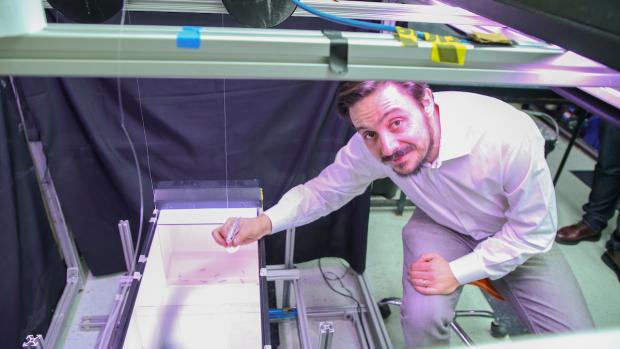Spotlight on Maurizio Porfiri

Institute Professor Maurizio Porfiri uses biomimetic robots to study animal behavior
Maurizio Porfiri is an NYU Tandon Institute Professor with appointments in the Departments of Mechanical and Aerospace Engineering, Biomedical Engineering, and Civil and Urban Engineering. As if that weren’t enough, he is also a core faculty member at the Center for Urban Science and Progress (CUSP), where his titles include inaugural Director of Doctoral Studies.
Even considering the premise that it takes multidisciplinary expertise to solve important problems, it’s an impressive array for just one engineer. Perhaps even more impressive is the wide variety of research that Porfiri, who is currently principal investigator or co-principal investigator on nine National Science Foundation-funded projects, undertakes.
Named to Popular Science’s “Brilliant 10” list for his work with biologically-inspired aquatic robots, he has also delved into issues involving gun violence, smart materials, and COVID-19, among other topics that might not, on the surface, seem to have much in common. Dig a little deeper, Porfiri asserts, and the commonality becomes clearer.
“How do animals behave? How do people reach consensus? How does a pandemic spread? What happens when particles collide?” he says. “These all involve dynamic, complex systems, and that’s the underlying layer. Once you decide upon the questions you want to answer — whatever those questions may be — you need to study the interactions taking place.” It’s easy to see, then, why Porfiri’s research space at NYU Tandon is called the Dynamical Systems Laboratory.
Porfiri has long been poised to tackle problems from a broad perspective. “As an undergraduate, I tried courses in environmental engineering and aerospace engineering, but I felt boxed in,” he recalls. “I didn’t want to study the details of how to build a plane; I wanted to gain a fundamental understanding of what allowed a plane to fly in the first place. At the end, the only reason I graduated as an electrical engineer was that I was allowed only two changes in my curriculum, otherwise I would have tried them all and never graduated. At the end of the day, rules are good.” Still, he says, his diverse background allowed him to see similarities and analogies that might have escaped someone with a more homogenous background.
With so many important topics to explore, how does he decide where to turn his attention? It may be a more casual process than you would imagine, Porfiri says. “Topics catch my interest,” he explains. “It might be a discussion I’m having with my wife, a friend, or a colleague about the environmental hazards facing cities or a story in the newspaper about an increase in gun purchases.”
Once Porfiri begins exploring an issue, his work involves analyzing time-series data to come up with inferences, modeling systems in order to extrapolate information, and examining the control problems that emerge. “What I’m really doing is building basic tools that can be applied in a variety of areas,” he says. “For example, once I began using biologically-inspired robotic fish to understand collective animal behavior, I saw how I could easily extend that understanding to model human behavior, such as what spurs gun purchases or how people behave in a pandemic.”
Among some of the multifaceted NSF-funded projects he has undertaken:
- Engaging stroke patients and others with upper-limb weakness in interesting Citizen-Science initiatives that can be integrated into their otherwise tedious physical therapy regimes with the use of haptic joysticks, thereby increasing compliance and improving the experience of telerehabilitation.
- Building a mathematical model specifically for the city’s unique social and transportation structures using data from New Rochelle — the New York suburb first seriously afflicted by COVID-19. His goal: to help health and government leaders make smart, up-to-date testing and contact-tracing decisions.
- Developing mathematical models of ion transport in soft polymers to design sensors and actuators that can be integrated in robots.
- Disentangling causes from effects in coordinated swimming among large schools of fish in order to contribute a mathematically-principled, experimentally-grounded approach to quantifying information flow in ensembles of dynamical systems.
- Determining how the use of artificially intelligent tools in the medical field affects physician work practices and the expert-patient relationship.
- Advancing the understanding of the sometimes surprising causal relationships among potentially contributing factors to firearm-related harm, such as prevalence of gun purchases, state legislation, media exposure, and perceptions of firearm safety.
Porfiri — a native of Italy who earned his Ph.D. degree in Engineering Mechanics from Virginia Tech in 2006 and joined NYU Tandon that same year — always knew that he wanted to be an educator and researcher. (He actually holds multiple doctoral degrees; the one from Virginia Tech was earned when he was technically conducting post-doc studies there.) A popular graduate advisor, he hopes to instill in others the importance of fundamental research and the obligation to address issues of social importance.
At CUSP, a research center dedicated to developing novel data- and technology-driven solutions for complex urban problems, he is now planning to launch a new graduate concentration open to Ph.D. candidates from all departments who are interested in collaborating on cohesive strategies to make the cities of the future more sustainable, economically viable, and accessible.
It doesn’t matter whether your major is mechanical engineering, electrical engineering, computer science, or anything else. You just have to decide where you want to make an impact.” — Maurizio Porfiri





